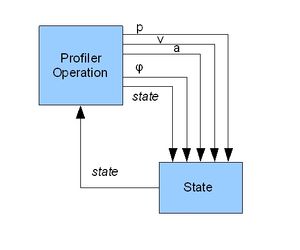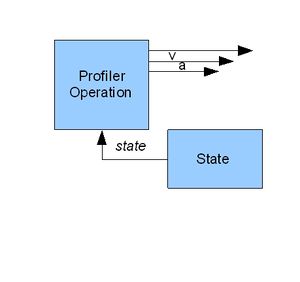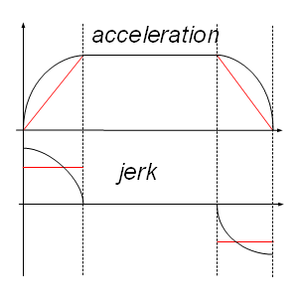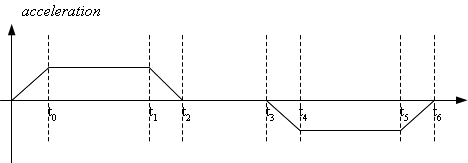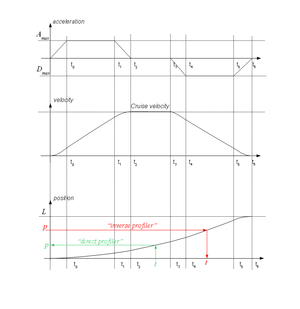Difference between revisions of "Time Based Profile (Trapezoidal Acceleration)/zh-hans"
| Line 53: | Line 53: | ||
系统原本只支持两种类型的运动曲线:正弦加速度(SA)和梯形加速度(TV)。用户通过定义平滑因子选择运动曲线:0 - TV,其他一切都是SA配置文件。这是非常直观的,因为梯形加速度(TV)是用户可以选择的最不平滑的配置文件(种类简单)。但是,这对于定义其他配置文件类型非常不方便。 因此引入了新的属性:<br> <ELEMENT>.[[MC-Basic:group.PROFILERTYPE| PROFILERTYPE]] | 系统原本只支持两种类型的运动曲线:正弦加速度(SA)和梯形加速度(TV)。用户通过定义平滑因子选择运动曲线:0 - TV,其他一切都是SA配置文件。这是非常直观的,因为梯形加速度(TV)是用户可以选择的最不平滑的配置文件(种类简单)。但是,这对于定义其他配置文件类型非常不方便。 因此引入了新的属性:<br> <ELEMENT>.[[MC-Basic:group.PROFILERTYPE| PROFILERTYPE]] | ||
| − | == | + | == 分析器特性 == |
[[Image:AXY-SA vs TA jerk profile.png|thumb|''Illustration 3: SA vs TA jerk profile'']] | [[Image:AXY-SA vs TA jerk profile.png|thumb|''Illustration 3: SA vs TA jerk profile'']] | ||
| − | + | 第一个基于时间的分析器实现的是梯形加速度曲线。 基于时间的分析器提供平滑的速度和位置曲线(“S”曲线)。 与正弦加速度曲线相比,该曲线对于相同的加速度具有减小的加加速度值,并且在加速度曲线中具有一个更多的加加速度不连续点。 然而,考虑到加加速度值也大约降低了三倍(3.14倍),可以假设两个曲线基本相同。 将TA转换为TV是通过减少加速度增加时间到比运动采样时间更短来完成的,与SA轮廓相反,这种变换有时默认地进行(加速时间小于5个样品)。 在该曲线类型中,通过J / A> T保证速度平滑度。 | |
| − | |||
[[File:AXY;Trpeze Accleration Profile.jpg|''Illustration 3: Trapezoidal Acceleration Profile'']] | [[File:AXY;Trpeze Accleration Profile.jpg|''Illustration 3: Trapezoidal Acceleration Profile'']] | ||
| − | === | + | === 反作用: === |
''The proposed profile (TA) is not able of having a '''non-zero initial and/or final velocity'''. This constrain causes the following limitations on use of ProfileType=2:<br/>'' | ''The proposed profile (TA) is not able of having a '''non-zero initial and/or final velocity'''. This constrain causes the following limitations on use of ProfileType=2:<br/>'' | ||
Revision as of 07:17, 9 May 2017
| 语言: | [[::Time Based Profile (Trapezoidal Acceleration)|English]] • [[::Time Based Profile (Trapezoidal Acceleration)/zh-hans|中文(简体)]] |
|---|
Contents
概述
本文档介绍了ControlStudio中的新运动分析器。 为了了解新的分析器的特性,我们首先描述当前的分析器实现。
两个分析器基本上都是在路径生成期间改变状态的状态机,并且基于每个状态使用不同的公式来计算分析器输出(位置,速度,加速度)。 这些状态是:加速度增加,加速度饱和,加速度减小,零加速度。可以在运动期间重复一些状态(例如,加速状态,然后是减速状态),并且可以完全省略一些状态(例如,在短暂运动中为零加速)。
这两个分析器之间的主要区别是状态选择算法,即系统从一个状态切换到另一个状态的条件。当前的实现(自版本4.5.25起的固件)主要以速度为基础。这意味着当前速度值是分析器切换到另一状态的主要标准。然而,速度值还不够,因此还要使用附加的内部变量:相位角,目标距离,分析器状态。
新的分析器(自版本4.5.25起)具有仅基于一个变量(当前时间)的状态变化条件。 离线预计算(这两个分析器都是共同的)将预先计算每个状态的切换时间,这将在状态改变时给出一个简单的条件。
这种方法比基于速度的分析器提供了一些好处。 其中之一是采用 safe SP blending feature.
| 基于时间的分析器 | 基于速度的分析器 | |
| RTK load | 非常小,因为没有检查制动距离 | 在每个采样中检查制动距离。 |
| 时间离散化 - 样本落在不同阶段之间 | 无,因为(p,v,a)值仅在当前时间值上计算 | 我们需要分别计算每个阶段,然后减去 |
| 轻松在线改变目标点 | 需要全部重复预计算 | 由于制动距离总是被检查,所以它相对来说比较麻烦。 |
| 时间驱动事件(即,在特定时间实例(在达到目标点之前)定义事件) | 一个简单的内置功能 | 非常不便于实施,因为我们实际上不知道运动的总执行时间 |
| 总执行时间的预测(例如,在SP混合中,防止第二运动在第二次完成之前进入) | 一个简单的内置功能 | 非常不便于实施,因为我们实际上不知道运动的总执行时间 |
实施细则
语言接口
系统原本只支持两种类型的运动曲线:正弦加速度(SA)和梯形加速度(TV)。用户通过定义平滑因子选择运动曲线:0 - TV,其他一切都是SA配置文件。这是非常直观的,因为梯形加速度(TV)是用户可以选择的最不平滑的配置文件(种类简单)。但是,这对于定义其他配置文件类型非常不方便。 因此引入了新的属性:
<ELEMENT>. PROFILERTYPE
分析器特性
第一个基于时间的分析器实现的是梯形加速度曲线。 基于时间的分析器提供平滑的速度和位置曲线(“S”曲线)。 与正弦加速度曲线相比,该曲线对于相同的加速度具有减小的加加速度值,并且在加速度曲线中具有一个更多的加加速度不连续点。 然而,考虑到加加速度值也大约降低了三倍(3.14倍),可以假设两个曲线基本相同。 将TA转换为TV是通过减少加速度增加时间到比运动采样时间更短来完成的,与SA轮廓相反,这种变换有时默认地进行(加速时间小于5个样品)。 在该曲线类型中,通过J / A> T保证速度平滑度。
反作用:
The proposed profile (TA) is not able of having a non-zero initial and/or final velocity. This constrain causes the following limitations on use of ProfileType=2:
- The execution of VORD change will be postponed to the first motion entered after its change, i.e., there is no on-line change of velocity command.
- Motion with StartType immediate or fast-immediate is be not allowed with this profile.
- In SP-Blending mode, it will be relatively simple to add a feature that prevents entering a third movement before the second one is complete.
- The new profiler allows introducing time-events prior to motion end.
- Concatenation (Vfinal ≠ 0) – not possible as this type of profiler does not accept nonzero initial and/or final velocities.
- BlendingMethod = 1 (Continuous Path) is not be functional with (PrfType = 2). In this case blending is done in profile-following mode where only one motion executes profile and the other just follows it:
- BlendingMethod = 2 (Super-Position) is fully operational.
- BlendingMethod = 3 (AI) is fully functional and independent from selected profile type.
New blending properties
Coding Issues
Time Based profiler will have three different functional part and this is the same way we have today with the default Velocity based profile:
- Pre-Computation, part where the given user parameters of velocity, acceleration and jerk are transformed into actual operational values.
- Real-time executioner that is called each sampling period and produce next (position, velocity, acceleration) triple.
- Inverse profiler function, routine that computes internal profiler parameter based on given position inside profiler path. In velocity based profile this function is non-trivial, in time based profile this function is much simpler and will be in the form of . This ability is crucial in implementing BlendProtected feature of the SP blending.
See Also
--Mirko 08:22, 20 December 2010 (CET)
